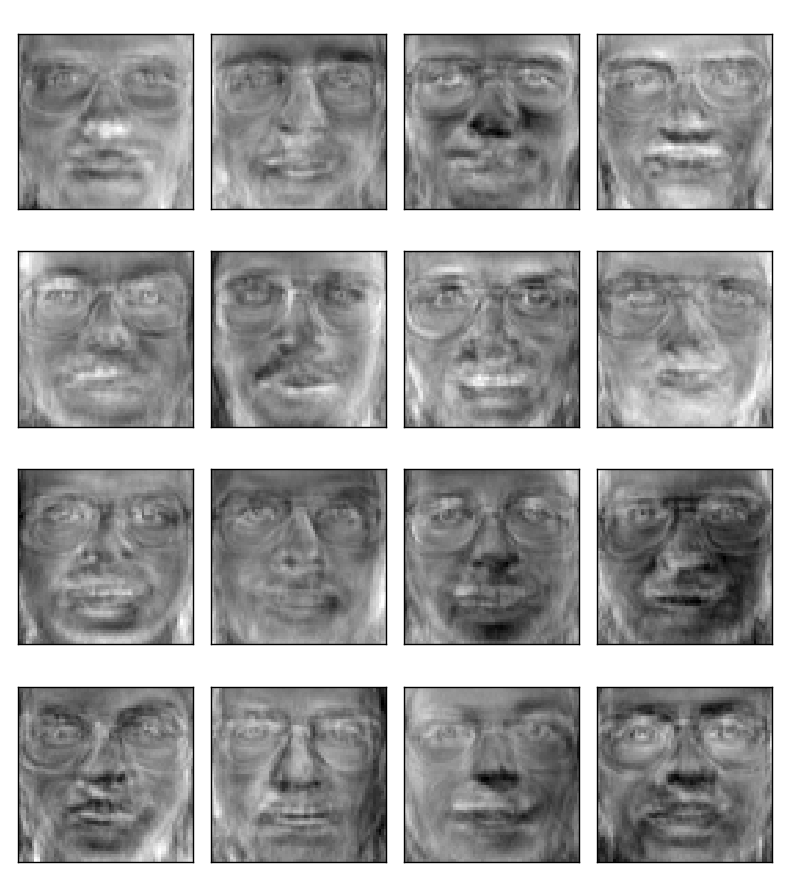Eigenvectors - in sound and vision
The concept of dimensions pops up within a multitude of contexts and even in every day life on a regular basis; a line is one-dimensional, a cube has 3 dimensions etc. It may generally be defined as the minimum number of coordinates required to uniquely describe a point within a space. However, different contexts require different definitions. In terms of vector spaces, one valid definition of dimension is the cardinality of the generating set of that space.
To reduce dimensions of high-dimensional data points we need to project them to a not-so-high-dimensional space. To do so one must find components/vectors which maximize variance. These components are called eigenvectors and are the result of a principal component analysis (PCA). High-dimensional data points (e.g. an image or a song) of some dimension \(d_1\) are projected to a hyperplane of dimension \(d_2 << d_1\). This hyperplane is spanned by eigenvectors. It would be nice to make this concept a little more tangible, to visualize it in some way. And, while we are at it, there is no need to restrict ourselves to the visual modality, we can also try and make a high dimensional space (or it’s reduced components) audible as well.
Eigenfaces are probably the most popular eigenvectors.
The face space
A picture is most naturally represented as a matrix of pixel values. However, the rows of the matrix might as well be concatenated into one long row vector, i.e. be represented as points in an ‘image space’. For simplicity’s sake let’s narrow it down some more and consider only gray scale images and only images depicting human faces. Despite these constraints, your ‘face space’ is still huge, for 250x250 pixel images its dimension is just that, 62500.
Eigenfaces are the eigenvectors of the covariance matrix of the face vector space.
Step by step:
Let \(P\) be a matrix build from row vectors \(P_i^T, \; 1 \leq i \leq N\)
\[P = \begin{bmatrix} P_1^T \\ \dots \\ P_N^T \\ \end{bmatrix}\]where the \(i^{th}\) row vector \(P_i^T\) is
\[(\underbrace{P_{i1} - \bar{P}_{i1}}_{\text{1st mean-subtracted pixel of } i^{th} \text{ picture}} \dots \; P_{im}-\bar{P}_{im})\]The scatter matrix then is
\[S = P^TP \in [0,1]^{m^2 \times m^2}\]So \(S\) is a \(m^2 \times m^2\) matrix, where \(m\) is the number of pixels in one picture.
Now the last step is to compute the eigenvectors of \(S\), but even if we use small images, \(S\) will be huge and computation expensive.
Game over?
No! Fortunately we can make use of the following property:
If \(v\) is an eigenvector of \(PP^T\) then:
\[(P^TP) P^Tv = \lambda P^Tv\]This means we can compute the eigenvectors of \(P^TP\) by computing the eigenvectors of the much smaller matrix \(PP^T \in [0,1]^{N \times N}\):
Let \(e_i\) be such an eigenvector, then: \(P^Te_i\) is an eigenvector of \(P^TP\) Now normalize \(P^Te_i\) and the results are the eigenfaces:
\[eigenface_i = \frac{P^Te_i}{||P^Te_i||}\]All this can be directly translated to Python (numpy is your friend):
def eigen(p):
from numpy import linalg
p = np.matrix(p)
p_ = p.mean(axis=0)
P = p - p_
evalues,evectors = linalg.eig(np.dot(P, np.transpose(P)))
args = evalues.argsort()
evectors = evectors[args]
evectors = evectors[::-1]
P_evectors = [(np.dot(np.transpose(P), np.transpose(evector)))
for evector in evectors]
eigen = map(lambda e: e/np.linalg.norm(e), P_evectors)
return eigenfrom sklearn.datasets import fetch_olivetti_faces
n_row, n_col = 4, 4; n_eigenfaces = n_row * n_col
faces = fetch_olivetti_faces(shuffle=True,random_state=RandomState(0)).data
eigenface = eigen(faces)
plot_gallery("Eigenfaces", eigenface[:n_eigenfaces], n_col, n_row)
Eigenbach?
The function eigen(.) is not specially tailored for faces. As long as the argument is a matrix…
So what happens if our argument is a matrix of sound files? How about some Johann Sebastian Bach?
Well, the problem is:
> du -sh /home/f/Musik/Johann\ Sebastian\ Bach/Bach\ Complete\ Works\
15G /home/f/Musik/Johann Sebastian Bach/Bach Complete WorksAs written above; the task would be to multiply \(P\) with \(P^T\), but these matrices are 15G large…
So since Bach was quite productive I chose a very small subset, namely The Well-Tempered Clavier (a reasonable set of 98 .mp3 files). I converted the .mp3s to .wavs using mpg123 and then used the first million frames of every .wav, which then resulted in 1000000/44100 = 22.68 s long eigenclaviers \(c_i, 0 \leq i \leq 96\) or rather partial-eigenclaviers (slowly eigen* becomes a well-worn prefix).
However I uploaded the first ten. Out of the first ten, these three may be the most interesting: